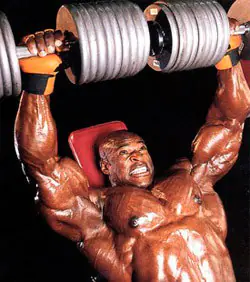To the editor of our site regularly come emails from our newbie readers with the same ones, surprising with their consistency and similarity, questions:
- How to determine the optimal weight of the weight?
- How many approaches should you do for one exercise?
- How many repetitions should I do in one approach?
- How much rest do you need between sets when training weights?
- How much rest between sets when training for relief?
- How many reps should you do in a superset?
- and others…
Well, in this article we will try to explain how to determine for yourself optimal projectile weight, quantity repetitions, sets, pauses between them, and we will give very specific real examples...
But first, let's find out what it is force, and where does it come from...
Strength is due to the manifestation of some relatively independent abilities:
- self-power (maximum strength),
- speed-strength (explosive),
- strength endurance.
Strength abilities are of greatest practical interest to those involved in fitness and bodybuilding.
Methods and methodological techniques used in domestic bodybuilding to develop strength and increase muscle mass can be divided into two groups:
- transferred to athleticism from the theory and methodology of general physical education and sports training.
- those that were developed and experimentally substantiated by foreign professional bodybuilders.
Strength development occurs when a person performs physical exercises overcoming external resistance or counteracting it through muscle tension. Based on the goals and objectives of athletic training, external resistance can be selected from extreme to very small. V. M. Zatsiorsky recommends considering weight limit (resistance) such that the student can perform one repetition of the exercise in one approach, close to the limit - 2-3, large - 4-7, moderately large - 8-12, medium - 13-18, small - 19-25 and very small - over 25.
Extensive methods
For the development of one’s own strength abilities, manifested in relatively low-speed movements with high external weights and with isometric efforts, L.P. Matveev advises using "extensive" methods. They are based on performing exercises with an unlimited weight of weights, but with a maximum number of repetitions, and serve to increase the physiological diameter of the muscles and body weight, and increase the functional readiness of the athlete. The number of repetitions of cyclic movements in one set is from 5.6 to 7.8 (80-90% of the weight of the maximum external weight). To increase strength capabilities without significantly increasing their own weight, the athlete increases the number of repetitions to 3-5, increasing the weight of the weight, and if there is a need for muscle hypertrophy, uses weight 75-80% of the maximum with 8-12 repetitions per set.
Intensified methods are based on the use of repeated maximum and near-limit weights to increase the degree of strength, as well as speed-strength readiness.
Performing strength-oriented exercises in a dynamic mode with near-maximum weights allows you to successfully develop strength abilities in sports that require maximum manifestation of strength (powerlifting, arm wrestling, weightlifting, etc.). The range of weights used is from 80-90% to 95-100% of the maximum. In a separate training session, you can use up to 6 types of different exercises with sub-limit and maximum weights, with the same number of sets. The number of repetitions in each set is 2-4. Rest breaks between sets should be 3-5 minutes. Moreover, in order to clearly know how much to rest between approaches, you need to carefully monitor behind your weight, — lighter athletes have shorter pauses than heavier ones.
Isotonic regime
A variety of the dynamic mode of muscle contraction can be considered as proposed by V. N. Platonov isotonic mode of muscle work. It involves performing exercises with traditional classical weights (for example, a barbell), with constant resistance throughout the entire movement. However, this idea of the exercise is rather arbitrary, since the strength capabilities of the athlete during the execution of the movement change significantly as a result of changes in the magnitude of the levers and the angles of application of forces. Muscles experience maximum resistance, usually at different points in the range of motion:
Overcoming and yielding phases
Exercises with a barbell, shock absorbers, block devices and other weights should be performed at constant low speed, since only in this case the load acts on the muscles throughout the entire possible range of motion, ensuring the growth of muscle mass. At the same time, doing the exercises at high speed ineffective, since the maximum force at the start of movement gives the projectile inertial acceleration. In addition, the muscles, when performing some exercises in the final phases of the trajectory, are practically do not experience stress. This occurs in various types of weightlifting movements, flexion and extension of the limbs (for example, push-ups on parallel bars). Combination overcoming And inferior phases of muscle work allows for movements with a fairly large amplitude, which contributes to the manifestation and development of strength qualities.
In this part of the article, we examined the main aspects of training aimed at predominant strength development. So basically they train powerlifters. In the next part of the article you will learn more about nuances of training now already bodybuilders. We will continue the story about how many approaches you need to do, how many repetitions you need to do, how much you need to rest between approaches, but in honor of training to increase muscle volume. Every self-respecting athlete should know all this information by heart... So, read on...
Post Views: 108


